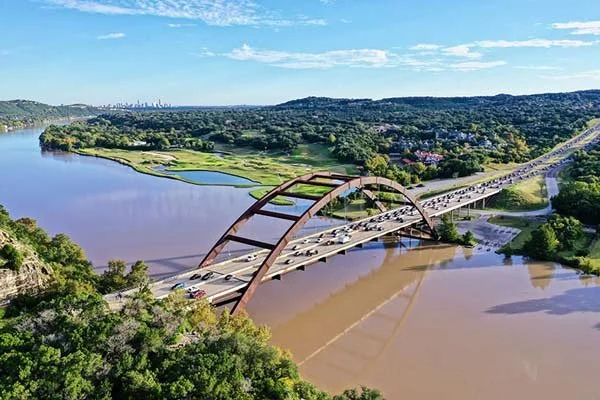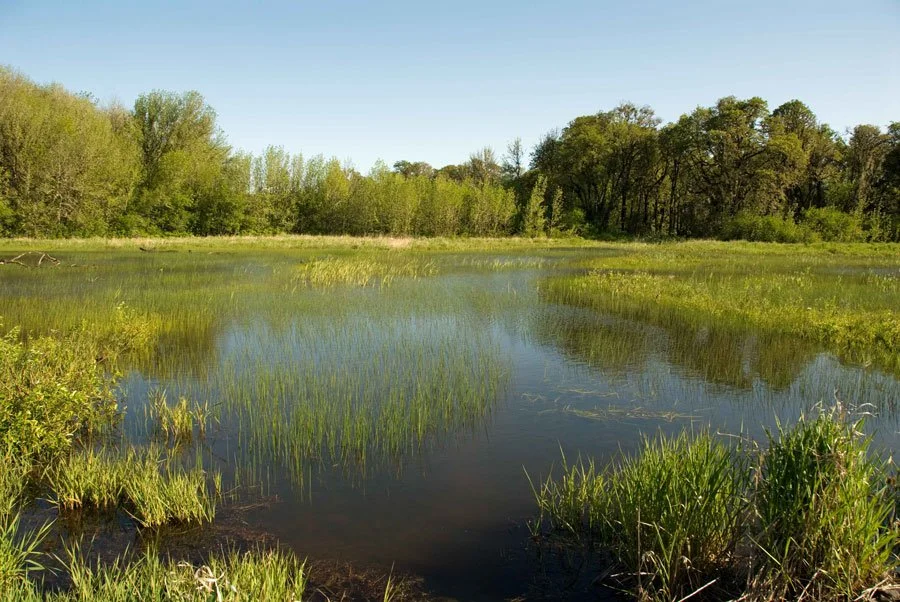Final NWPR Rule Published
by Stephen Meyer
austin, texas
Austin 360 Bridge
over the Colorado River
The Environmental Protection Agency (EPA) and U.S. Army Corps of Engineers (USACE) published the final rule in the Federal Register for the Navigable Waters Protection Rule (NWPR), which codifies the definition of waters of the United States (WOUS) subject to federal regulation under the Clean Water Act (CWA). This final rule comes after numerous Supreme Court decisions over the last few decades; the publishing and eventual revocation of an Obama-era rule defining WOUS, and the publication and comment period of the draft rule of the NWPR. The rule will go into effect June 22, 2020; however, there is a high likelihood the rule will be litigated and may not go into effect on the stated date with litigation likely extending into the next presidential term.
According to the NWPR, “as a baseline concept, this final rule recognizes that waters of the United States are waters within the ordinary meaning of the term, such as oceans, rivers, streams, lakes, ponds, and wetlands, and that not all waters are waters of the United States.” The NWPR defines WOUS in four different categories:
Territorial Seas and Traditional Navigable Waters;
Perennial and Intermittent Tributaries
Certain Lakes, Ponds, and Impoundments of Jurisdictional Waters; and
Wetlands Adjacent to other Jurisdictional Waters
The NWPR also defines “Waters and Features That are Not Waters of the United States.” (Not WOTUS)
Summaries of the four different categories for WOUS as defined in the NWPR are summarized below. Please note that these summaries are not exhaustive and certain details have not been included for brevity:
Territorial Seas and Traditional Navigable Waters
The territorial seas, and waters which are currently used, or were used in the past, or may be susceptible to use in interstate or foreign commerce, including waters which are subject to the ebb and flow of the tide. The boundary of these waters extends to the lateral extent of the ordinary high water mark or high tide line.
The ordinary high water mark is defined as “that line on the shore established by the fluctuations of water and indicated by physical characteristics such as a clear, natural line impressed on the bank, shelving, changes in the character of soil, destruction of terrestrial vegetation, the presence of litter and debris, or other appropriate means that consider the characteristics of the surrounding areas.”
Perennial and Intermittent Tributaries
Perennial tributaries are defined as tributaries (e.g. rivers, streams, or similarly naturally occurring surface water channels) having surface water flowing continuously year-round. Intermittent tributaries are defined as having surface water flowing continuously during certain times of the year and more than in direct response to precipitation. These tributaries must contribute surface flow to the territorial seas or traditionally navigable waters in a typical year either through one or more tributaries, lakes, ponds, and impoundments of jurisdictional waters, or adjacent wetlands. The boundary of these waters extends to the lateral extent of the ordinary high water mark or high tide line.
These tributaries do not lose jurisdiction if modified or if they contribute surface water flow to a downstream jurisdictional water in a typical year through channelized non-jurisdictional water features, through a subterranean river, culvert, dam, tunnel, or similar artificial feature, or through a debris pile, boulder field, or similar natural features. A typical year is defined as when precipitation and other climatic variables are within the normal periodic range (e.g., seasonally, annually) for the geographic area of the applicable aquatic resource based on a rolling thirty-year period.
san antonio, texas
The San Antonio Riverwalk is one of Texas’ most iconic landmarks, blending natural beauty with urban development.
As an integral part of the state’s navigable waterways, it plays a crucial role in both the local ecosystem and economy.
Understanding the classification of waterways like the Riverwalk is essential for environmental stewardship and regulatory compliance.
The NWPR impacts how waterways are protected and managed, ensuring that vital resources, such as the San Antonio River, remain sustainable for future generations.
aci environmental has a successful track record of helping clients across Texas and the Intermountain West to navigate these water rules.
Certain Lakes, Ponds, and Impoundments of Jurisdictional Waters
A lake, pond, or impoundment of jurisdictional waters is a WOUS if it is a traditional navigable water; contributes surface flow to the territorial seas or a traditionally navigable water in a typical year either directly or through one or more jurisdictional waters; or is inundated by flooding from the territorial seas or traditionally navigable waters, perennial or intermittent tributaries, or lakes and ponds and impoundments of jurisdictional waters in a typical year. These waters do not lose their jurisdictional status if they contribute surface water flow to a downstream jurisdictional water in a typical year through a channelized non-jurisdictional surface water feature, through a culvert, dike, spillway, or similar artificial feature, or through a debris pile, boulder field, or similar natural feature.
Wetlands Adjacent to other Jurisdictional Waters
Wetlands continue to be defined as “those areas that are inundated or saturated by surface or ground water at a frequency and duration sufficient to support, and that under normal circumstances do support, a prevalence of vegetation typically adapted for life in saturated soil conditions. Wetlands generally include swamps, marshes, bogs, and similar areas.” Wetlands continue to be identified by using the 1987 Wetlands Delineation Manual and its regional supplements.
Wetlands are considered jurisdictional when they are adjacent to any of the three previously described types of WOUS. Wetlands are considered adjacent to those WOUS when they abut, meaning to touch at least one point or side of a WOUS; are inundated by flooding from a previously described WOUS in a typical year; are physically separated from a WOUS only by a natural berm, bank, dune, or similar natural features; or are physically separated from a previously described WOUS in a typical year by a dike, barrier, or similar artificial feature as long as that structure allows for a direct hydrologic connection between the previously described WOUS in a typical year, such as a culvert, flood or tide gate, pump, or similar artificial feature. An adjacent wetland is jurisdictional in its entirety when a road or similar artificial structure divides the wetland, as long as the structure allows for a direct hydrologic surface connection through or over that structure in a typical year.
Photo by Gentry George, U.S. Fish and Wildlife Service
Waters and Features That are Not Waters of the United States.
The following are not WOUS:
Waters or water features not previously identified as WOUS;
Groundwater, including groundwater drained through subsurface drainage systems;
Ephemeral features, including ephemeral stream, swales, gullies, rills, and pools, where ephemeral is defined as surface water flowing of pooling only in direct response to precipitation;
Diffuse stormwater run-off and directional sheet flow over upland;
Ditches that are not territorial seas, traditionally navigable waters, or perennial or ephemeral tributaries, or constructed in non-adjacent wetlands. Ditches are defined as a constructed or excavated channel used to convey water;
Prior converted cropland, where prior converted cropland mean any area that, prior to December 23, 1985, was drained or otherwise manipulated for the purpose, or having the effect, or making production of an agricultural product possible, as long as the area has not been abandoned and returned to a wetland condition, which can occur in five years;
Artificially irrigated areas; including fields flooded for agricultural production, that would revert to upland should application of irrigation water to that area cease;
Artificial lakes and ponds, including water storage reservoirs and farm, irrigation, stock watering, and log cleaning ponds, constructed or excavated in upland or in non-jurisdictional waters, so long as those artificial lakes and ponds are not impoundments of WOUS;
Water-filled depressions constructed or excavated in upland or in non-jurisdictional waters incidental to mining or construction activity, and pits excavated in upland or in non-jurisdictional waters for the purpose of obtaining fill, sand, or gravel;
Stormwater control features constructed or excavated in upland or in non-jurisdictional waters to convey, treat, infiltrate, or store stormwater run-off;
Groundwater recharge, water reuse, and wastewater recycling structures, including detention, retention, and infiltration basins and ponds, constructed or excavated in upland or in non-jurisdictional waters; and
Waste treatment systems.
Uplands are non-jurisdictional and are defined as any land area that under normal circumstances does not satisfy all three wetland factors (i.e., hydrology, hydrophytic vegetation, hydric soils) required to classify an area as wetland, and, does not lie below the ordinary high water mark or the high tide line of a jurisdictional water.





